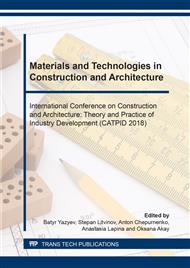[1]
V.O. Chulkov, M.S. Kiselev, О.S. Konishcheva, Compositional Infographic Modeling of the Interconnection of the Parameters of the Converted Systems. MGSU Herald, Scientific and technical journal. 3 (2007) 107-108. (In Russian).
Google Scholar
[2]
V.O. Chulkov, INFOGRAPHY, Vol. 1: Multilevel infographic modeling. Modular course of lectures. A series of Infographic foundations of functional systems, (IFFS)., Moscow, SVR-ARGUS, 2007. (In Russian).
Google Scholar
[3]
V.O. Chulkov, S.V. Mareev, D.Yu. Korotkov, Compositional model of complex reliability of the system «man - technology - environment», Industrial and civil construction. 11 (2008) 56.
Google Scholar
[4]
World Health Organization, Constitution of the World Health Organization, Chronicle of the World Health Organization. 1 (1-2) (1947) 29-43.
Google Scholar
[5]
J.E. Singer, The need to measure lifestyle. Int. Rev. Appl. Psychol. 31 (1982) 303-315.
Google Scholar
[6]
V.A. Hansen, System descriptions in psychology, Leningrad, Leningrad State University, (1984).
Google Scholar
[7]
W.S. Merlin, Essay integral study of personality, Moscow, Pedagogy, 1986. (In Russian).
Google Scholar
[8]
A.R. Kagee, D.N. Dixon, Worldview and health promotion behavior: a causal model, Journal of Behavioral Medicine. 23 (2) (2000) 169-179.
Google Scholar
[9]
V.J. Sutherland, C.L. Cooper, Strategic stress management: an organizational approach, London, Macmillan, (2000).
Google Scholar
[10]
D.C. Watson, B.K. Sinha, Stress, emotion, and coping strategies as predictors of personality disorders. Imagination, Cognition & Personality. 19 (3) (2000) 279-294.
DOI: 10.2190/8ywv-ra4m-cg9n-tb5r
Google Scholar
[11]
S.S. Mulkana, B.J. Hailey, The role of optimism in health-enhancing behavior. American Journal of Health Behaviors. 25 (4) (2001) 388-395.
DOI: 10.5993/ajhb.25.4.4
Google Scholar
[12]
A.M. Ridley, B.R. Clifford, The effects of anxious mood induction on the adjective to misleading post-event information, Applied Cognitive Psychology. 18(2) (2004) 233-244.
DOI: 10.1002/acp.963
Google Scholar
[13]
J.K. Maner, J.A. Richey, K. Cromer, M. Mallott, C.W. Lejuez, T.E. Joiner, N.B. Schmidt, Dispositional anxiety and risk-avoidant decision-making, Personality and Individual Differences, 42 (2007) 665-675.
DOI: 10.1016/j.paid.2006.08.016
Google Scholar
[14]
V.O. Chulkov, Geometric modeling in the complex documentation of engineering objects (infographics), Moscow, MICE, 1989. (In Russian).
Google Scholar
[15]
O.P. Musaeva, Automation of the design of interrelated geometric models of objects and processes in the design, Moscow, MICE, 1989. (In Russian).
Google Scholar
[16]
V.I. Potapov, Theoretical bases and methods of integration in the systems of automated design of construction objects, Moscow, VICE, 1990. (In Russian).
Google Scholar
[17]
V.P. Bolotov, Geometric and software complex of interactive computational and graphic programming in CAD, Vladivostok, FESU, 1993. (In Russian).
Google Scholar
[18]
G.A. Denisov, Development of the system of organisational management of innovative programs, Moscow, MSUCE, 1995. (In Russian).
Google Scholar
[19]
V.F. Yakovlev, Theoretical Foundations of Modeling Objects and Design Processes in Construction, Moscow, MSUCE, 1997. (In Russian).
Google Scholar
[20]
Yu.D. Kosorukov, Automation of designing of construction objects with a local adaptive system of interactive communication, Moscow, MSUCE, 1998. (In Russian).
Google Scholar
[21]
A.E. Semechkin, Infographic methods for organizing the reconstruction of residential quarters, Moscow, MSUCE, 1999. (In Russian).
Google Scholar
[22]
I.Ya. Masturov, Computer-aided design of monitoring of construction objects as habitat, Moscow, MSUCE, 1999. (In Russian).
Google Scholar
[23]
A.V. Ivashchenko, Computer technology of alternative form-building in the CAD of a dwelling by the criterion of comfort level of habitat, Moscow, TsNIIOMTP, 2001. (In Russian).
Google Scholar
[24]
I.I. Veikum, Computer-aided design of intelligent monitoring for the reconstruction of a dwelling, Moscow, TsNIIOMTP, 2001. (In Russian).
Google Scholar
[25]
S.G. Ovchinnikov, Automation of the design of multifunctional blocked and zoned intelligent buildings, Moscow, TsNIIOMTP, 2002. (In Russian).
Google Scholar
[26]
V.Yu. Boykov, Substantiation and development of technologies for the formation of the operational quality of industrial and civil buildings in the process of reorganization, Moscow, TsNIIOMTP, 2006, 16. (In Russian).
Google Scholar
[27]
O.P. Sannikova, Theoretical and methodological bases of studying individual differences, Science and education, Special issue Psychology of personality: theory and practice,. 9 (2010) 3-7. (In Russian).
Google Scholar
[28]
V.O. Chulkov, G.O. Chulkov, I.Ya. Masturov, On a conceptual model of trends in the changes in the level of comfort in the area of its existence for an orthogonal (rectangular) dwelling, Sat. doc. Moscow City Workshop, Moscow, SEARCH,, 1996. (In Russian).
Google Scholar


